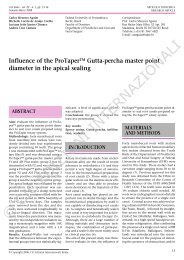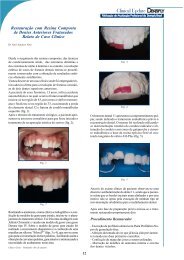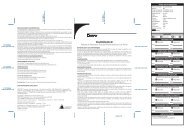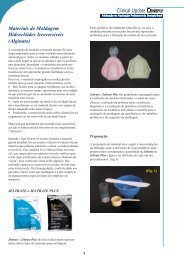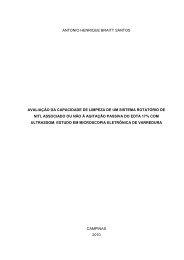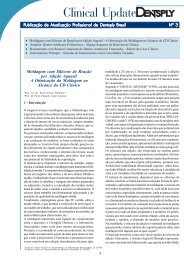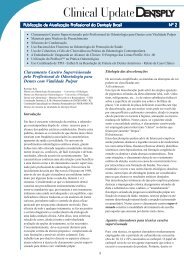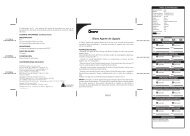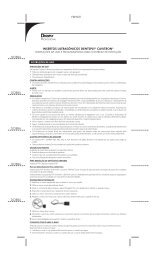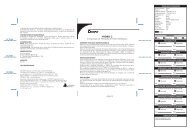You also want an ePaper? Increase the reach of your titles
YUMPU automatically turns print PDFs into web optimized ePapers that Google loves.
Effectiveness of All-in-one Adhesive Systems Tested by<br />
Thermocycling Following Short and Long-term Water<br />
Storage<br />
Uwe Blunck a /Paul Zaslansky b<br />
Purpose: To evaluate and compare the marginal integrity of in vitro Class V restorations made with all-in-one adhesive<br />
systems by thermocycling after different periods of water storage, to provide an analysis of static and quasi-dynamic<br />
deterioration in water.<br />
Materials and Methods: Standardized Class V cavities (17 groups, 8 specimens each) were prepared in extracted<br />
human caries-free anterior teeth. The cavities were filled using 14 all-in-one adhesive systems/composite resin combinations<br />
in addition to the multi-bottle adhesive systems Syntac and OptiBond FL (etch-and-rinse technique) and<br />
Clearfil SE Bond (self-etching) as controls. The samples were thermocycled after water storage for 21 days, after 1<br />
year and again after 3 years (2000 cycles between 5 and 55°C) and replicas were made before and after each thermocycling<br />
treatment (TC) for quantitative marginal analysis in the SEM.<br />
Results: In dentin, marginal adaptation showed no significant differences between all groups after the first TC. After<br />
one year of water storage and a second TC, the results for Prompt L-Pop (1999), Adper Prompt L-Pop/Tetric Ceram,<br />
and One-up Bond F Plus showed a statistically significant decrease of margin quality 1 (MQ1) score compared to the<br />
reference groups. When the all-in-one adhesives G-Bond, AQ-Bond, Hybrid Bond, and One-up Bond F Plus were used,<br />
the enamel margins of restorations showed lower percentages of “continuous margins” (p < 0.05) after 1 year of<br />
water storage and TC. Of the materials tested after 3 years of water storage and TC, only AQ Bond had a significantly<br />
lower MQ1 score.<br />
Conclusion: While all materials exhibited deterioration in the MQ1 quality score, the rate of deterioration varied, and<br />
the results show that different materials have different deterioration rates after initial vs long-term water storage. The<br />
deterioration along margins in dentin was not as extensive as predicted from other studies; however, the results from<br />
the enamel margins show that one-bottle all-in-one adhesives seem to be significantly affected by water storage. The<br />
results of this study suggest that the all-in-one adhesive group members perform very differently from each other:<br />
thus, data need to be explored further at the level of each different adhesive product<br />
Keywords: marginal quality evaluation, in vitro Class V restorations, adhesive system effectiveness.<br />
J Adhes Dent 2007; 9: 231-240. Submitted for publication: 15.12.06; accepted for publication: 4.1.07.<br />
a Associate Professor, Charité-Universitätsmedizin Berlin, Dental School, Campus<br />
Virchow Klinikum, Berlin, Germany.<br />
b Staff Scientist, Max Planck Institute of Colloids and Interfaces, Department of<br />
Biomaterials, Potsdam, Germany<br />
Paper presented at Satellite Symposium on Dental Adhesives, Dublin,<br />
September 13th, 2006.<br />
Reprint requests: Dr. Uwe Blunck, Charité-Universitätsmedizin Berlin, Dental<br />
School, Campus Virchow Clinic, Augustenburger Platz 1, 13353 Berlin, Germany.<br />
Tel: +49-30-450-562-673, Fax: +49-30-450-562-961.<br />
Adhesive systems are routinely used to improve the marginal<br />
seal of composite resin restorations at the interfaces<br />
with enamel and dentin. Bonding between enamel or<br />
dentin and the restorative composite must be sufficiently effective<br />
to resist the varying stresses to which a “typical”<br />
restoration is subjected. Such stresses include the polymerization<br />
shrinkage during composite placement as well as<br />
mechanical, thermal, and hydration stresses incurred in the<br />
oral environment due to normal use and wear. 25<br />
Available adhesive systems may be classified as dentinconditioning<br />
adhesive systems with selective acid etching<br />
on enamel, etch-and-rinse systems which necessitate phosphoric<br />
acid etching and rinsing of enamel/dentin prior to ap-<br />
Vol 9, Supplement 2, 2007 231



